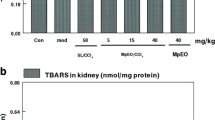Abstract
Extracts of Phellinus linteus (EPB), grown on germinated brown rice, protected rats from liver injury induced by carbon tetrachloride (CCl4). Peroxidation products in the liver were decreased to 10% by EPB. Catalase and superoxide dismutase activities were significantly decreased to 55% and 39% by CCl4 administration, but EPB blocked this effect, resulting in enzyme activities at control levels. Expression of cytochrome P450 2E1 (CYP2E1) protein was significantly decreased to 88% in CCl4-treated rats but remained at control levels when EPB was also administered. EPB did not affect the altered fatty acid composition induced by CCl4. The hepatoprotective effect of EPB may be mediated by EPB's prevention of CCl4-induced CYP2E1 degradation.
Similar content being viewed by others
References
Aebi H (1984) Catalase in vitro. Meth. Enzymol. 105: 121–126.
Buege JA, Aust SD (1978) Microsomal lipid peroxidation. Meth. Enzymol. 52: 302–310.
Forni LG, Packer JE, Slater TF, Willson RL (1983) Reaction of the trichloromethyl and halothane-derived peroxy radicals with unsaturated fatty acids: a pulse radiolysis study. Chem. Biol. Interact. 45: 171–177.
Han SB, Lee CW, Jeon YJ, Hong ND, Yoo ID, Yang KH, Kim HM (1999) The inhibitory effect of polysaccharides isolated from Phellinus linteus on tumor growth and metastasis. Immunopharmacology 41: 157–164.
Hunt JR, Johnson LK, Juliano BO (2002) Bioavailability of zinc from cooked philippine milled, undermilled, and brown rice, as assessed in rats by using growth, bone zinc, and zinc-65 retention. J. Agric. Food Chem. 28: 5229–5235.
Kim HM, Han SB, Oh GT, Kim YH, Hong DH, Hong ND, Yoo ID (1996) Stimulation of humoral and cell mediated immunity by polysaccharide from mushroom Phellinus linteus. Int. J. Immunopharmacol. 18: 295–303.
Lee DW, Yu BP (1990) Modulation of free radicals and superoxide dismutase by age and dietary restriction. Aging Clin. Exp. Res. 2: 357–362.
Lin JM, Lin CC, Chiu HF, Yang JJ, Lee SG (1993) Evaluation of the anti-inflammatory and liver-protective effects of Anoectochilus formosanus, Ganoderma lucidum and Gynostemma pentaphyllum in rats. Am. J. Chin. Med. 21: 59–69.
Moody DE, James JL, Clawson GA, Smuckler EA (1981) Correlations among the changes in hepatic microsomal components after intoxication with alkyl halides and other hepatotoxins. Mol. Pharmacol. 20: 685–693.
Oh SH (2003) Stimulation of gamma-aminobutyric acid synthesis activity in brown rice by a chitosan/glutamic acid germination solution and calcium/calmodulin. J. Biochem. Mol. Biol. 36: 319–325.
Park JS, Lee BR, Jin LH, Kim CK, Choi KS, Bahn JH, Lee HY, Chang HW, Baek NI, Lee EH, Kang JH, Cho SW, Choi SY (2001) The stimulatory effect of Garnoderma lucidum and Phellinus linteus on the antioxidant enzyme catalase. J. Biochem. Mol. Biol. 34: 144–149.
Perez MJ, Cederbaum AI (2003) Metallothionein 2A induction by zinc protects HepG2 cells against CYP2E1-dependent toxicity. Free Radic. Biol. Med. 34: 443–455.
Recknagel RO (1967) Carbon tetrachloride hepatotoxicity. Pharmacol. Rev. 19: 145–208.
Recknagel RO, Glende Jr EA, Dolak JA, Waller RL (1989) Mechanisms of carbon tetrachloride toxicity. Pharmacol. Ther. 43: 139–154.
Teselkin YO, Babenkova IV, Kolhir VK, Baginskaya AI, Tjukavkina NA, Kolesnik YA, Selivanova IA, Eichholz AA (2000) Dihydroquercetin as a means of antioxidative defence in rats with tetrachloromethane hepatitis. Phytother. Res. 14: 160–162.
Vittozzi L, Nastainczyk W (1987) Binding of reactive metabolites of CCl4 to specific microsomal proteins. Biochem. Pharmacol. 36: 1401–1406.
Author information
Authors and Affiliations
Corresponding author
Rights and permissions
About this article
Cite this article
Jeon, T.I., Hwang, SG., Lim, B.O. et al. Extracts of Phellinus linteus grown on germinated brown rice suppress liver damage induced by carbon tetrachloride in rats. Biotechnology Letters 25, 2093–2096 (2003). https://doi.org/10.1023/B:BILE.0000007071.28105.c1
Issue Date:
DOI: https://doi.org/10.1023/B:BILE.0000007071.28105.c1




